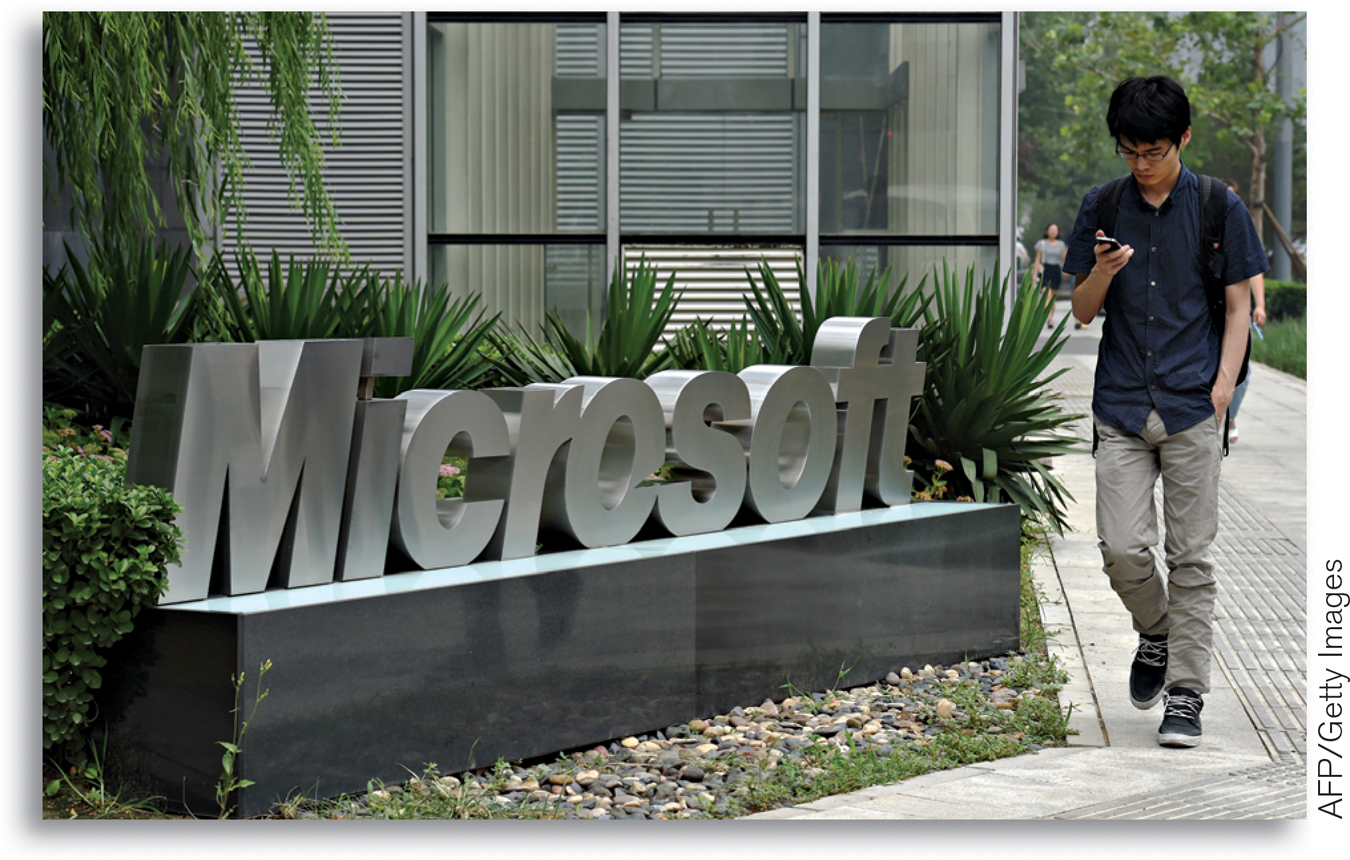Network Externalities
In Chapter 13 we explained that a network externality exists when the value of a good or service is greater when a large number of other people also use the good or service. Although network externalities are common in technology-
What a network externality shares with positive and negative externalities is an external effect: one person’s actions affect the payoff to another person’s actions. Network externalities play a key role both in the economy and in a number of regulatory policy controversies.
The External Benefits of a Network Externality
We can now deepen our understanding of network externalities by noting that a network externality involves an external benefit: one person’s adoption of a good or service extends an external benefit to another person who also adopts that good or service. As a result, the marginal benefit of the good or service to any one person depends on the number of other people who also use it.
Although the most common network externalities involve methods of communication—
The classic case of network externalities in the high-
Today, social media websites are perhaps the best illustration of a network externality at work, a subject we’ll address in this chapter’s business case.
A good is subject to positive feedback when success breeds greater success and failure breeds further failure.
When a network externality arises from the use of a good or service, it leads to positive feedback, also known as a bandwagon effect: if large numbers of people use it, other people become more likely to use it too. And if fewer people use the good or service, others become less likely to use it as well. This leads to a chicken-

An important way to gain an advantage at the early stages of a market with network externalities is to sell the product cheaply, perhaps at a loss, in order to increase the size of the network of users. For example, Skype, the internet calling company, allows free calls from one Skype member to another Skype member via the internet. This builds Skype’s network of users, who will then pay for using Skype to call a non-
Network externalities present special challenges for antitrust regulators because the antitrust laws do not, strictly speaking, forbid monopoly. Rather, they only prohibit monopolization—efforts to create a monopoly. If you just happen to end up ruling an industry, that’s OK, but if you take actions designed to drive out competition, that’s not OK. So we could argue that monopolies in goods with network externalities, because they occur naturally, should not pose legal problems.
Unfortunately, it isn’t that simple. Firms investing in new technologies are clearly trying to establish monopoly positions. Furthermore, in the face of positive feedback, firms have an incentive to engage in aggressive strategies to push their goods in order to increase their network size and tip the market in their favor. So what is the dividing line between legal and illegal actions? In the Microsoft antitrust case, described next, reasonable economists and legal experts disagreed sharply about whether the company had broken the law.
ECONOMICS in Action: The Microsoft Case
The Microsoft Case
In 2011, a consent decree between Microsoft and a federal court prohibiting certain business practices expired, marking the end of an era for the company. Beginning in 1998, the federal Justice Department as well as 20 states and the District of Columbia sued Microsoft, alleging predatory practices against competitors to protect the monopoly position held by its Windows operating system. At the time, Microsoft was by any reasonable definition a monopoly, as just about all personal computers in the late 1990s ran Windows. And the key feature supporting this dominance was a network externality: people used Windows because other people used Windows.

Despite urging by some economists, the Justice Department did not challenge the Windows monopoly itself, as most experts agreed that monopoly was the natural outcome of an industry with network externalities. What Justice Department lawyers did claim, however, was that Microsoft had used the monopoly position of its Windows operating system to give its other products an unfair advantage over competitors.
For example, by bundling Internet Explorer free as part of Windows, it was alleged that Microsoft had given itself an unfair advantage over rival web browser Netscape, because it prevented Netscape from charging customers for its use. The Justice Department argued that this was harmful because it discouraged innovation: potential software innovators were unwilling to invest large sums out of fear that Microsoft would bundle an equivalent software with Windows free. Microsoft, in contrast, argued that by setting the precedent that companies would be punished for success, the government was the real opponent of innovation.
After many years of legal wrangling, the consent decree was signed in 2002, which barred Microsoft from excluding rivals from its computers and forced the company to make Windows seamlessly interoperable with non-
Although the case against Microsoft consumed many tens of millions of dollars in legal costs and is considered one of the most significant antitrust cases of its generation, its long-
Two effects, however, are beyond dispute. Because of Microsoft’s example, products with network externalities are often priced at a loss or even at zero—
Quick Review
Network externalities arise when the value of a good increases when a large number of other people also use the good. They are prevalent in communications, transportation, and high-
technology industries. Goods with network externalities exhibit positive feedback: success breeds further success, and failure breeds further failure. The good with the largest network eventually dominates the market, and rival goods disappear. As a result, in early stages of the market, firms have an incentive to take aggressive actions, such as lowering price below production cost, to enlarge the size of their good’s network.
Goods with network externalities pose special problems for antitrust regulators because they tend toward monopoly. It can be difficult to distinguish what is a natural growth of the network and what is an illegal monopolization effort by the producer.
16-4
Question 16.7
For each of the following goods, explain the nature of the network externality present.
Appliances using a particular voltage, such as 110 volts versus 220 volts
8½-by-
11- inch paper versus 8- by- 12½-inch paper
Question 16.8
Suppose there are two competing companies in an industry that has a network externality. Explain why it is likely that the company able to sustain the largest initial losses will eventually dominate the market.
Solutions appear at back of book.
Are We Still Friends? A Tale of Facebook, MySpace, and Friendster
There was a big shake-
By 2013, MySpace’s registered users fell by a third, to 36 million, compared to 54 million in 2011. As the former president of MTV Networks, Michael J. Wolf, commented, “MySpace was like a big party, and then the party moved on. Facebook has become much more of a utility and communications vehicle.” MySpace became difficult to navigate and cluttered with pop-

Friendster’s demise began in 2009 when a change of interface and technical problems upset users while Facebook was on the rise. As one expert noted, Friendster imploded in a systematic way: first less-
The events of 2011 were not what industry insiders had expected. In 2005, the newspaper conglomerate News Corporation bought MySpace for $580 million. Until April 2008, the number of MySpace users consistently exceeded the number of Facebook users. After the acquisition, News Corporation announced an ambitious revenue target of $1 billion. But to meet these goals, ads were accepted that made the site slow, buggy, and difficult to use. By 2011 MySpace was losing money and News Corporation sold it for $35 million, a 94% loss over 6 years.
Chris Wolfe, a founder of MySpace, tried to explain the reversals: “The paradox in business is, ‘When do you focus on growth, and when do you focus on money? We focused on money and Facebook focused on growing the user base and user experience.’” In contrast to MySpace, Facebook refused to be acquired by a larger company, allowing it to ignore revenue goals. That is, until 2012 when Facebook began a push to open its website to ads, provoking a backlash among users. Some observers have warned that Facebook could go the way of Friendster, as it has experienced a dramatic decline among younger users, who have switched to competitors like Snapchat, Instagram, Tumblr, and Twitter. Stay logged on, somewhere, for the outcome.
QUESTIONS FOR THOUGHT
Question 16.9
g4Y7lP+HkmhWqGVywu9HE3IgZ4TARx6bJtsM6562shYIyEgW8Vss3QHIMYisH1YBzdRJYPzP0j6BUumAzvyfwDDU9rY=Describe the nature of the externality in social media websites.Question 16.10
ShdTus0HyYV72SvajjcOU9DryY2S86pZfTkEyMQJxC2RTn6qdA7X/c3kpDlSDRr0bvWeH0u1Hf7zqlopsHXy/E/UWKzWO2j54CN/N0jismmEe+TwCkLsyyIgMZbmWaVnarw8cVfuy1lHNg5FpXU+w9jtnJT3hwb29RIwR4SlPMm+eBtpwm83jA3rdvj5R1EiJ5lg4pBvD3CLZgApPuiV3MUdmpcOH0Y7EgL5d7hBd+WcsbYmAtlYtMokKtGhtj+ZvaKuV/ttP8v8QIz+ZDQpMw==Assume that there are two competing social media websites. Explain why it is likely that one will come to dominate. Explain why the decline of a site is likely to be swift, with a cascade of departures.Question 16.11
wOfzbvmvgPS/dm7KYGl67jAwhsCkUa7BmUD6iczQ/ts9c7Yj8s4XNg/bfQ2fPw0MkUtWw3/vkXWGd37TIROHbPWEJZ8f5wbR1adBTrh76RNFyaDb0RXd2H4LR60vC3l+VUwys63xH+UQYRZWgS9OsMnfaJaXf28i4AWDlRTUxl+ejI/vWiSA3/MnM4eUQgLCExplain the nature of the problem that undermined MySpace relative to Facebook. Is it unique to MySpace or common to all social media sites?